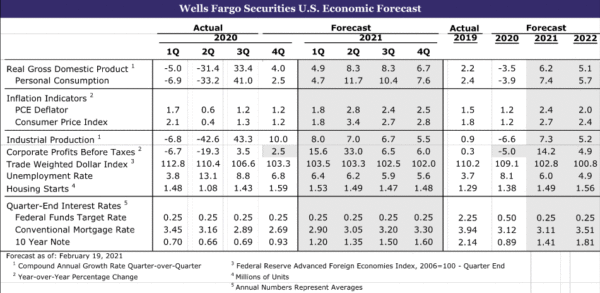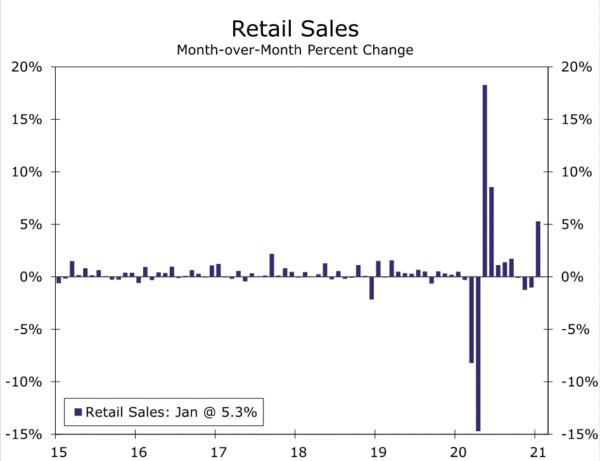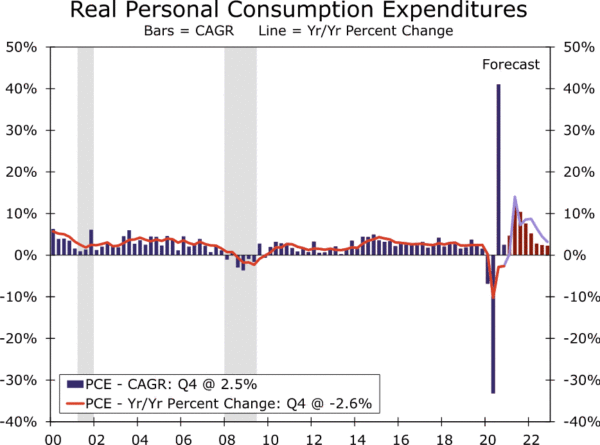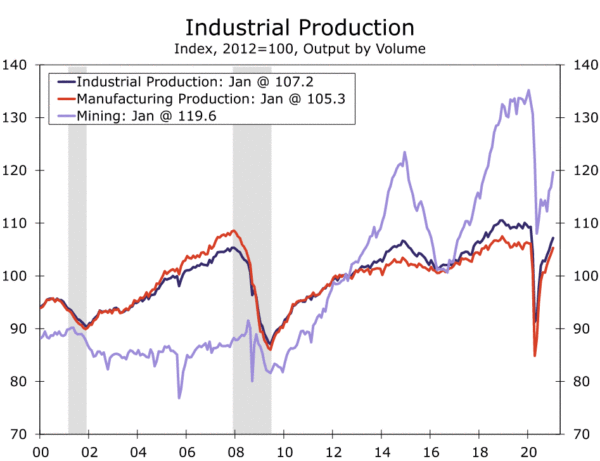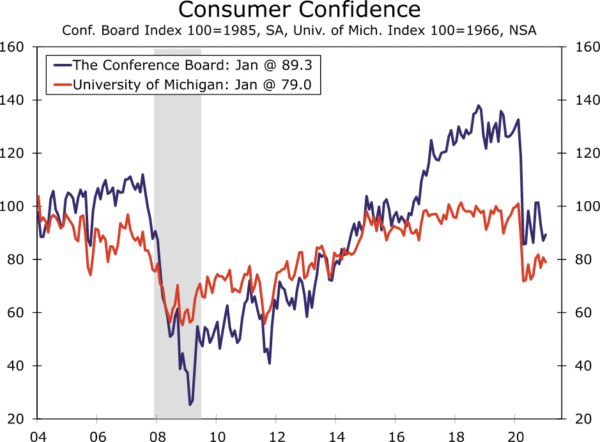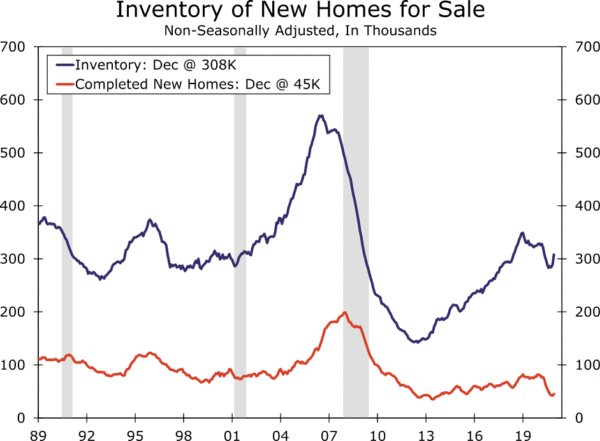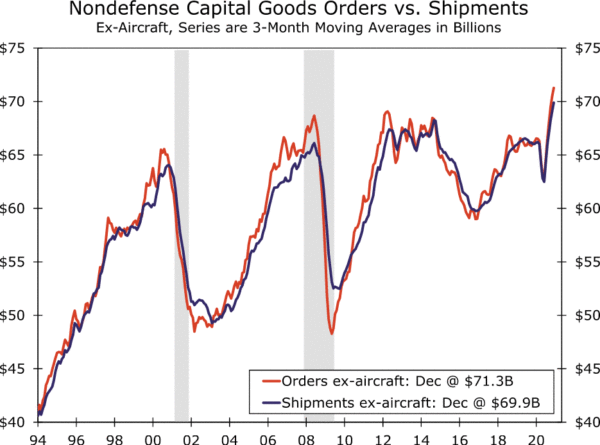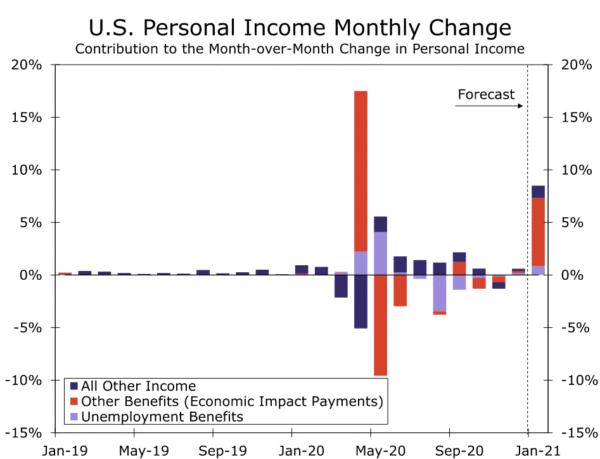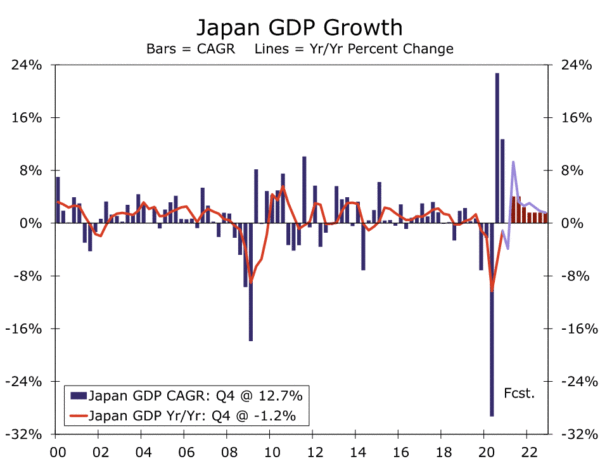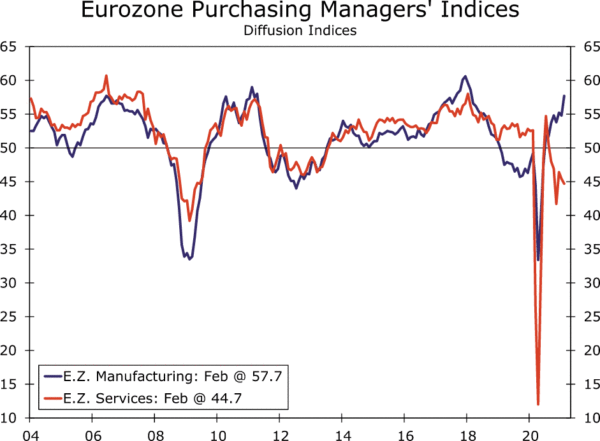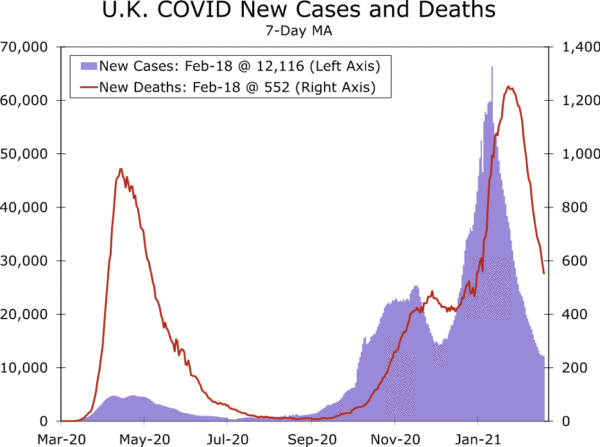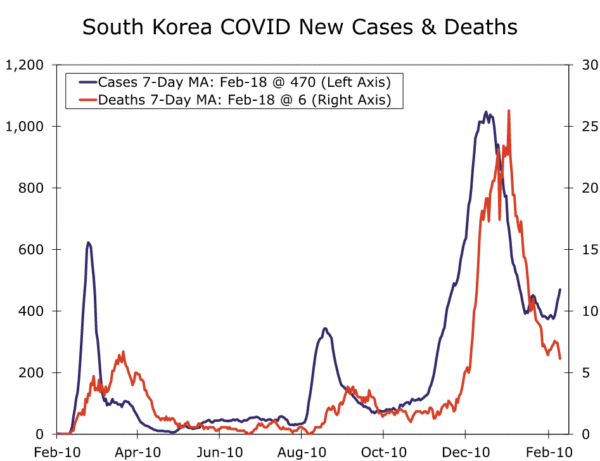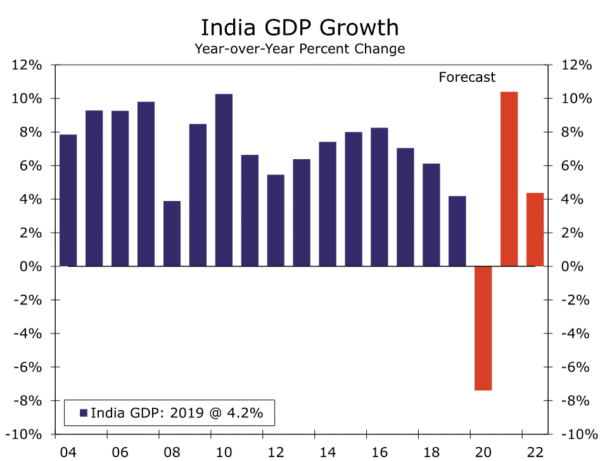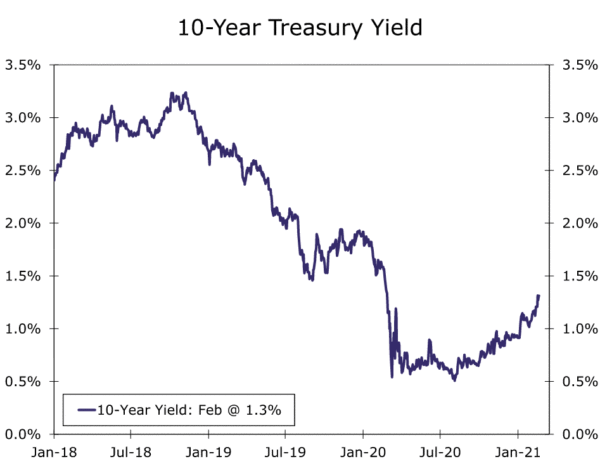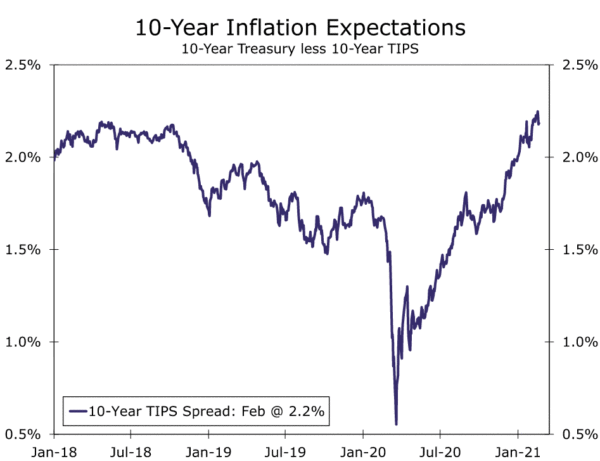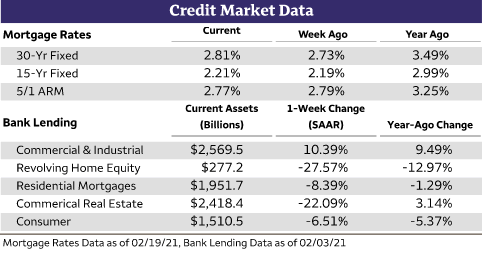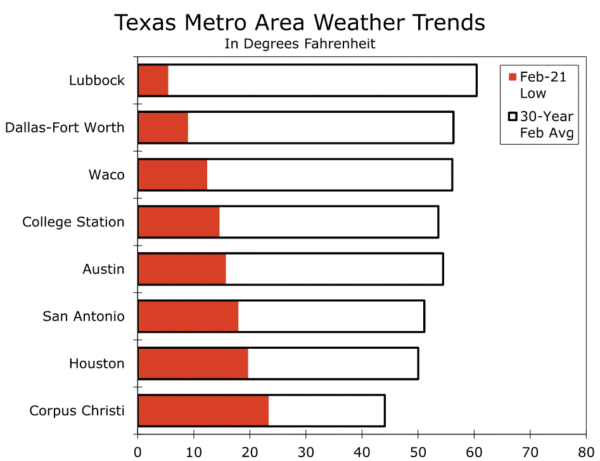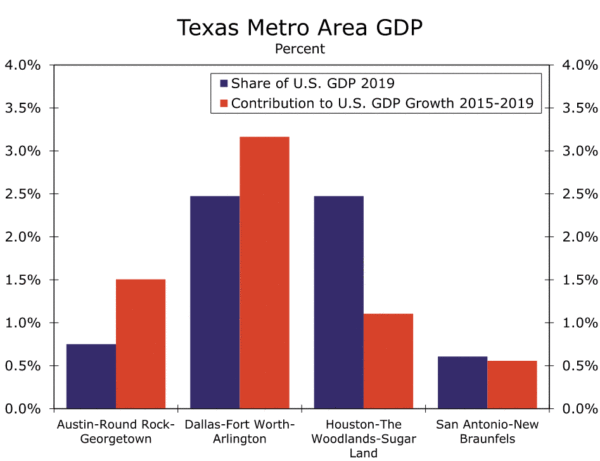U.S. Review
A Consumer and His Stimulus Check Are Soon Parted
- Stimulus checks from the year-end COVID-relief package arrived in January, and we learned this week that retailers raked in more money during that month than they have since June. Every single store category reported increasing sales during the month. With even more stimulus on the way, we are ratcheting up our forecast for consumer spending.
- The other big economic story this week is the winter storm that knocked out power to large swaths of the country, bringing misery and devastation to a place not accustomed to dealing with arctic cold and snow. We address what all that means for the economy in our Topic of the Week.
Global Review
Q4 GDP Data Top Expectations, but Q1-2021 Looking Shakier
- Data on Japanese real GDP growth in Q4-2020 beat expectations. Economic growth in Japan was 3.0% quarter-over-quarter (not annualized), and the composition of growth was well-balanced.
- The Eurozone economy contracted 0.6% quarter-over-quarter (not annualized) in the fourth quarter and declined 5.0% on a year-over-year basis. Initial data for Q1-2021 show signs that the Eurozone economy is still contracting. Preliminary Eurozone PMIs for February were released this morning and showed continued contraction in the service sector.
- Data released this morning showed that the British consumer continued to face significant headwinds amid elevated COVID cases and government restrictions. U.K. retail sales declined 8.2% month-over-month in January, and the contraction was 8.8% when excluding gasoline sales.
U.S. Review
Upgrading Our Forecast for Consumer Spending
The 5.3% increase in the January retail sales report this week was significantly better than expected. In fact, it was better than any of the 68 economists who submitted a forecast on Bloomberg. After a particularly strong surge in goods spending in the middle part of last year, we expected retailers to limp across the finish line last year (which they did) and we expected that air pocket in goods spending would carry into the start of 2021 (which it clearly did not). We were right about the air pocket, but perhaps off on the timing. The soft patch we have been forecasting in goods spending appears to have been brought forward into the end of last year. Meanwhile, the roughly $900 billion in additional COVID-fiscal stimulus passed late last year started making its way to households in January. Most households received direct checks early in the month, while unemployment benefits were increased, and it appears households spent at least some of that extra income during January.
The January retail sales report highlights the role of fiscal policy in boosting consumer spending. Every single store type posted sales gains in January, with most retailers seeing the largest gain in sales since the summer. With yet another round of stimulus on the horizon, we are upgrading our forecast for consumer spending.
The Check Is in the Mail…Again
The trajectory of our forecast is more or less the same as it was previously, we have just front loaded more spending into the second and third quarters. This is based partly on what the January retail sales report is telling us about the propensity to consume in the context of stimulus (the latest round of stimulus checks went out in January) as well as our expectation that the next round of stimulus will be consistent with the “go-big” mindset that has been gaining momentum among policymakers in recent weeks and which is polling well among American voters of both parties.
Rather than assuming a $1 trillion COVID-relief deal with risks skewed to the upside regarding total size, we are now anticipating something roughly half-again as large, in the neighborhood of $1.5 trillion, with the risks now more balanced. While some of this larger dollar amount will show up in the form of more state and local aid, a lot of it will show up in slightly bigger direct checks, more generous jobless benefits for a couple of extra months, and a child tax credit expansion we had not previously baked into our forecast. This suggests even stronger personal income than we had been forecasting previously.
The net result of these changes is that we are now forecasting double-digit percentage growth rates for PCE in the second and third quarters and full-year growth that now comes in at 7.4% for 2021, versus 5.7% previously.
Other Forecast Changes: Trade and Output
With a stronger profile for consumer spending we have also revised our imports forecast higher. We were already forecasting a fairly strong pace of import growth this year, but given our increased expectations around consumption and still-lean inventory levels, we’ve nudged imports a touch higher in the first and second quarters. Stronger imports will result in a larger drag on GDP growth this year, which offsets some of the gain coming from consumer spending. We now expect imports to shave 1.4 percentage points off of headline growth in 2021, up from 1.1 percentage points previously.
A solid outturn reported this week for industrial production in January was largely due to strength in the key manufacturing sector, though mining helped. Looking ahead, we already expected some short-term weakness before production turns sharply higher later this year. The storms this week likely mean the disruption will be more than a stutter step. For this reason, we have taken down our production estimates for the first quarter, though we still anticipate a sharp rebound in industrial output later this year and into 2022.
In considering these adjustments to our forecast, we are now forecasting GDP to grow 6.2% in 2021 and 5.1% in 2022.
U.S. Outlook
Consumer Confidence • Tuesday
Consumer confidence should hold up in February, but any improvement will likely be incremental. On a positive note, virus case counts have tumbled since mid-January with the number of new cases roughly in line with where they were at the start of November. Lower cases should provide some upward support to confidence, as should improved prospects for further fiscal stimulus. A significant counterweight to solid confidence, however, is the severe weather storms across many parts of the country. A preliminary read on consumer sentiment from the University of Michigan showed still-hesitant consumers, with sentiment falling to a six-month low of 76.2 in February. Final results from the University of Michigan are due Friday.
By both measures, confidence remains subdued. Although not nearing the depths reached in the 2008 downturn, confidence has yet to meaningfully improve since its April plunge and remains more restrained than the hard spending data would suggest. Even with ample fiscal support and record amounts of excess personal saving, we do not expect confidence to meaningfully regain ground until we see further progress on vaccine administration and a more robust recovery in the labor market.
- Previous: 89.3
- Wells Fargo: 89.6
- Consensus: 90.0
New Home Sales • Wednesday
After a banner year, we forecast new home sales continued their ascent in January. The housing market has been on a tear, supported by record-low mortgage rates, demographic tailwinds and desire for more living space, all of which we do not expect to subside anytime soon.
We look for new home sales to rise to an 868,000-unit pace in January. Inventories of completed homes likely remained exceptionally low last month, after notching an all-time low in December. On a months’ supply basis, inventories ticked up to 4.3 months at December’s sales price. Relatively tight inventories coupled with the recent surge in demand have pulled home prices higher, as have higher construction costs. Lumber prices have soared and shortages of other key materials have made it more difficult to profitably build lower-priced homes. For these reasons, the median sales price of a new home likely continued to rise in January.
- Previous: 842K
- Wells Fargo: 868K ; Consensus: 859K (SAAR)
Durable Goods Orders • Thursday
The manufacturing sector has rebounded smoothly, and we expect strong activity continued into the new year. When it comes to durable goods, the recovery is already complete. The level of core capital goods orders and shipments are both already higher than they were prior to the pandemic.
Manufacturing has largely benefited from a shift in consumer demand to goods rather than services amid the inability to participate in many in-person activities. A shift in business needs at the onset of the pandemic also provided a jolt to the manufacturing sector, particularly for equipment needed to facilitate work during the pandemic (e.g. computers). An unwinding of these dynamics as vaccines are distributed and activity in the service sector resumes is a potential headwind for manufacturing later this year, but durable goods orders likely held up in January. The ISM manufacturing index did slip to 58.7 last month, led by a decline in new orders. But, rising backlogs and low inventories should keep production rolling at a strong rate in coming months, particularly given our increased expectation for stronger near-term goods consumption.
- Previous: 0.5% (Durable Goods Orders) & 1.1% (Durables Ex Transportation)
- Wells Fargo: 0.3% & 0.5% ; Consensus: 1.3% & 0.6% (MoM)
Personal Income & Spending • Friday
We’re braced for a blowout report for January personal income and spending on Friday. Our forecast for an 8.5% gain in personal income largely reflects the COVID relief package passed late last year. In fact, 7.4% of our projected gain in income comes from the government transfer line, reflecting extended enhanced unemployment benefits and about 70% of the economic impact payments (direct checks) sent to households in the beginning of January. Outside of government transfers, the all-important employee compensation component, which typically represents a majority of personal income growth, should also post a gain based on the January employment report.
We’re also looking for a sizable jump in personal spending. The January retail sales data came in much better than expected (see U.S. Review), notching the largest monthly pick up in sales since June and suggesting that consumers spent at least a portion of the extra stimulus income. We see no reason to bet against this strong showing for the consumer and expect that strength to also be evident in the personal spending data. Personal spending is a much broader measurement of consumption than retail sales, which primarily tracks actual in-store retailers and mostly only covers goods consumption. The components of retail sales account for only about 40% of total personal spending due to its inclusion of services consumption. The divergence in measurement is a main reason we expect a more modest gain in personal spending (+2.5%) compared to the 5.3% rise in retail sales. Still, a plus-2% single-month gain in personal spending is rare, and if realized it would mark the fastest pace of consumption since households were coming out of lockdowns in June.
- Previous: 0.6% (Personal Income) & -0.2% (Personal Spending)
- Wells Fargo: 8.5% & 2.5% ; Consensus: 10.0% & 0.7% (MoM)
International Review
Q4 GDP Data Top Expectations, but Q1-2021 Looking Shakier
Data on Japanese real GDP growth in Q4-2020 beat expectations. Economic growth in Japan was 3.0% quarter-over-quarter (not annualized), and the composition of growth was well-balanced. Most demand components saw increases, including consumer spending (2.2% quarter-over-quarter) and business capital spending (4.5%). As a result, private demand rose 2.0%, while public demand rose 1.8%, and the net export sector also contributed to the Q4 growth beat. Overall Q4 GDP was down just 1.2% year-over-year (top chart). To put that in perspective, U.S. real GDP was down 2.5% year-over-year in Q4-2020, and Eurozone real GDP was down 5.0% (more on that below).
Despite the out-performance, Japan’s economy faces a more unsettled outlook in early 2021. The early part of this year saw a surge in new COVID cases well above previous peaks, though still much lower than in many other advanced economies. The fastest pace of increase in new COVID cases was seen in mid-January at around 6,500 new cases per day, although case counts have receded subsequently. As the number of newly reported COVID infections reached record levels, the Japanese government declared a state of emergency in January, which was later extended in February in order to prevent the spread of the virus. The implementation of emergency measures is set to remain in place until March 7. As a result, the fourth quarter strength in the Japanese economy may give way to some weakness when the Q1-2021 data are reported.
Real GDP data for the Eurozone were also reported this week, and the print came in a touch better than expected. The Eurozone economy contracted 0.6% quarter-over-quarter (not annualized) in the fourth quarter and declined 5.0% on a year-over-year basis. Among the largest economies in the bloc, Italy and France saw relatively large quarter-over-quarter declines of 2.0% and 1.3%, respectively, while Spain saw a 0.4% increase and German output was up 0.1%.
As we enter 2021, the Eurozone faces a much bigger economic hole than the United States, Japan, Canada or Australia. Initial data for Q1-2021 show signs that the Eurozone economy is still contracting. Preliminary Eurozone PMIs for February were released this morning and showed continued contraction in the service sector (middle chart). At 44.7, the services PMI has not been above 50 since August. The manufacturing PMI was much stronger at 57.7, but since services comprise the bulk of the Eurozone economy, another quarterly contraction is likely in store for Q1-2021 GDP.
Last week, U.K. real GDP data were released, and the data painted a mixed picture for the British economy. The headline number topped expectations, but the composition of growth was less favorable. Government spending was largely responsible for the out-performance, while consumer spending turned negative in Q4. U.K. Data released this morning showed that the British consumer continued to face significant headwinds amid elevated COVID cases and government restrictions. U.K. retail sales declined 8.2% month-over-month in January, and the contraction was 8.8% when excluding gasoline sales.
The United Kingdom saw a renewed surge in COVID cases in early 2021 (bottom chart), which led the U.K. government to reimpose restrictions. Protocol included restricting individuals from leaving their home unless it is for a permitted reason such as shopping for necessities, going to work if you cannot reasonably do so from home, exercising with your household or support bubble in a public outdoor space, meeting your support bubble, seeking medical assistance or attending education or childcare. The U.K. government has signaled it will outline a tentative timetable for exiting the current lockdown restrictions on February 22. Still, even as developments on the virus front improve, the U.K. economy looks certain to suffer a notable hit to activity during the first quarter.
International Outlook
Bank of Korea Meeting • Wednesday
South Korea saw a spike in COVID cases in Q4-2020, but it does not appear to have dinged the economy’s recovery too badly. Real GDP growth was +1.1% quarter-over-quarter in Q4. Private consumption declined amid the public health challenges, but solid growth in gross capital formation and exports helped propel the South Korean economy higher. South Korean economic output was “only” down 1.4% compared to Q4-2019, and this marks one of the stronger performances in the developed world.
In its most recent monetary policy decision, the Bank of Korea (BoK) noted a phenomenon with which many U.S. watchers will be familiar: low inflation but accelerating asset prices. Core CPI inflation was just 0.9% year-over-year in South Korea, and the central bank anticipates that it will remain around this pace for the foreseeable future. Asset prices, however, have climbed as “[domestic] stock prices have surged…and housing prices have accelerated in all parts of the country.” With consumer price inflation low, the BoK will likely maintain its accommodative monetary policy stance for some time.
Although higher interest rates may not be in the cards anytime soon, with South Korea a major exporter and tightly integrated into the global economy, we expect the global economic recovery to benefit the Korean won, albeit at a gradual pace, over the longer term.
- Previous: 0.50%
- Consensus: 0.50% (7-Day Repo Rate)
India Q4 GDP • Friday
The Indian economy showed some encouraging signs of continued recovery in the final calendar year quarter of 2020. A composite PMI for the Indian economy crossed back above the 50 threshold in September, up from a stunning low of 7.2 in April, and has held comfortably above that level through January. Q3 GDP surprised to the upside, and at its meeting on February 5 the Reserve Bank of India (RBI) noted that “high frequency indicators—railway freight traffic; toll collection; e-way bills; and steel consumption—suggest that revival of some constituents of the services sector gained traction in Q3 (October-December).”
As of this writing, the Bloomberg consensus is looking for Indian real GDP growth in Q4-2020 of +0.5% year-over-year, up from -7.5% in Q3-2020. Like many major economies, the Indian economy has recovered more quickly than many analysts expected earlier in the pandemic. That said, even with output returning to roughly 2019 levels, significant levels of uncertainty remain, and there is still economic damage that must be undone. Against that backdrop, we anticipate additional monetary policy easing from the RBI in 2021.
- Previous: -7.5%
- Consensus: 0.5% (YoY)
Interest Rate Watch
FOMC Minutes Suggest Fed Not Overly Concerned with Inflation
Long-term interest rates have been moving higher in recent weeks as expectations of stronger growth post-pandemic continue to grow. Indeed, the yield on the benchmark 10-year Treasury note rose to its highest level in roughly a year this week (see chart). As measured by the yield spread between this benchmark government bond and the 10-year inflation-protected note, expectations of the average inflation rate over the next 10 years have risen. At roughly 225 bps, these expectations are at their highest level in seven years (see chart).
Will these market-based measures of higher inflation expectations concern policymakers at the Federal Reserve? Probably not, if the minutes of the January 26-27 meeting of the Federal Open Market Committee (FOMC) are any indication. Consistent with recent public comments by Fed policymakers, the minutes show that most committee members do not view inflation as being much of a concern at present. Although most FOMC participants expect that year-over-year rates of consumer price inflation will move modestly higher later this year, they largely view those increases as stemming from one-off adjustments in the price level and not the start of a long period of price acceleration. The FOMC seems to be largely focused on the labor market, rather than inflation, at present. The minutes noted that “the economy was far from achieving the Committee’s broad-based and inclusive goal of maximum employment and that even with a brisk pace of improvement in the labor market, achieving this goal would take some time.”
The takeaway is that the FOMC likely will maintain its current target range of 0.00% to 0.25% for the fed funds rate for quite some time. (We forecast through at least the end of 2022.) Furthermore, the Fed likely will continue its monthly purchase rate of $80 billion worth of Treasury securities and $40 billion worth of mortgage-backed securities for the foreseeable future. (We forecast through the end of the year.) These purchases should help to offset some upward pressure on the long end of the yield curve.
Topic of the Week
Arctic Blast Hits Central U.S.
A polar vortex unleashed heavy snowfall, ice and record-low temperatures across most of the central U.S this week. While harsh winter weather is a fairly normal occurrence in the Midwest and Mountain regions, a number of southern states have seen temperatures drop to close to zero for the first time since the late 1980s. What’s more, the plunge in temperatures has led to an unexpected surge in demand for electricity and heating fuels like oil, natural gas and propane. Unfortunately, much of the southwestern region’s energy grid has now come under tremendous strain alongside spiking energy demand. Frozen instruments at gas, coal and nuclear plants have complicated the matter, as the region’s energy supplies have dwindled amid a collapse in generating capacity. The shortfall in supply has pushed oil and natural gas prices to their highest levels in months and also has forced regulators to reduce gas supplies for commercial and industrial uses to ensure heating for households and critical customers, such as power plants and hospitals.
The cold weather appears to be hitting Texas especially hard as grid failures have been severe throughout the state. With much of the state essentially shut down, the Texas economy may take a temporary hit as businesses are shuttered, industrial production is idled, agriculture operations are halted, oil wells are shut in and consumers are staying indoors.
Areas brought to a standstill this week include some of the nation’s largest and most rapidly growing economies. Dallas-Fort Worth and Houston are the nation’s fourth- and fifth-largest metros, respectively. Robust population growth over the past 30 years may explain why the state’s energy infrastructure has faltered. The last time the state has experienced prolonged winter weather was in the late 1980s, and the state population has expanded at a 1.8% average annual rate between 1990 and 2019. The state’s four largest metro areas have grown at an even faster rate.
Most metro areas punch well above their weight in terms of overall economic growth. The Dallas-Fort Worth, Austin and San Antonio metro areas account for 3.8% of U.S. GDP and were responsible for 5.2% of GDP growth between 2015 and 2019. Economic output in Houston, which has lagged in recent years due to subdued oil and gas activity, makes up about 2.8% of national GDP. That being said, the state’s economic recovery is unlikely to be knocked off course by the storm, even if there are temporary disruptions. The Texas economy has held up better compared to other states amid the recent COVID spike. Employers in the state have regained about 64% of the jobs lost during the lockdown months last spring, more than other large states. Longer term, Texas will continue to benefit from the accelerated in-migration of businesses and residents from higher-cost coastal areas. In short, Texas has become a hot-bed of economic activity over the past few years, which will help the state’s economy recover rapidly from the temporary economic disruptions caused by the freezing winter weather.




